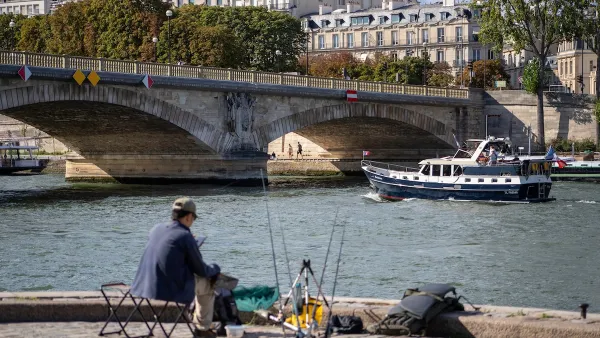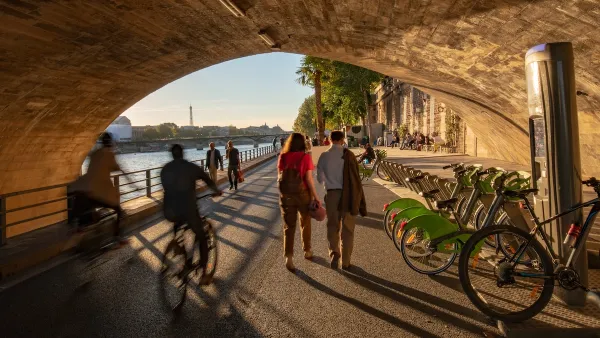I just got back from my first trip to Europe, where the cities are a lot older and a lot different than they are here in the New World. I made many observations on my brief trip, which included Paris and Barcelona, and I'm sure those will bubble up in blog posts in the near future. However, I won't waste anyone's time remarking about how great European cities are. We've all heard it before, and while it may be right, the point has been made. Like, really made. So, yes, the narrow streets are nice to walk on, the bike sharing system in Paris is awesome, and the architecture is impressive. But one piece of these cities that hasn't receioved enough praise is their garbage cans.
I just got back from my first trip to Europe, where the cities are a lot older and a lot different than they are here in the New World. I made many observations on my brief trip, which included Paris and Barcelona, and I'm sure those will bubble up in blog posts in the near future. However, I won't waste anyone's time remarking about how great European cities are. We've all heard it before, and while it may be right, the point has been made. Like, really made.
So, yes, the narrow streets are nice to walk on, the bike sharing system in Paris is awesome, and the architecture is impressive. But one piece of these cities that hasn't receioved enough praise is their garbage cans.
Specifically, I'm talking about Paris here, and more specifically, we can't even call them garbage cans. As you can see in the picture below (yes, I take pictures of garbage cans on vacation), these garbage "cans" are not much more than posts, hoops and plastic bags.
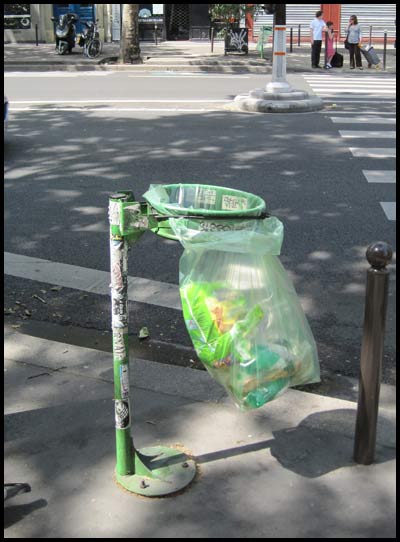
Now that's simple infrastructure. A post, a hoop and a bag. It's got to cost next to nothing to make one of these things – a lot less than a bulky concrete block or metal can like you see in many cities. But it gets the job done. Additionally, it makes trash collection really easy. A simple elastic bungee band holds the bag to the hoop, so all the trash collectors have to do is lift the band, take the bag, and add another. There's no reaching into a dark nasty can, no picking up and dumping out, and no gross garbage water pooling at the bottom for months or more.
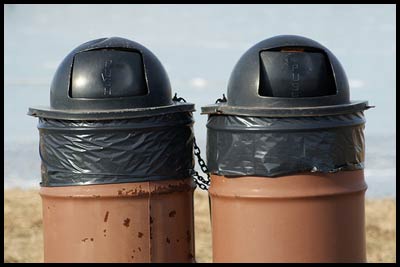
A local friend tells me the reason behind this system is less about efficiency than safety. The simple post-hoop-bag replaced the traditional concrete can holder after miscreants had caused a bunch of damage in 1995 hiding bombs inside garbage cans. To reduce that threat, the cans were replaced with clear plastic bags. Now not much can hide in the new garbage cans of Paris.
An additional benefit that may not be relevant in Paris but which would certainly be a big improvement in American cities is that, in the same way that police can see bombs in a clear plastic bag, people who collect bottles and cans don't have to reach into a can (or turn it over) to see if there are any recyclables inside. It makes life easier for those who make their living this way, and cuts down on the mess that results from those who do so inconsiderately.
But garbage on the street isn't really a problem in Paris, or at least it wasn't in the places I went. The reason, I'm guessing, has a lot to do with the sheer amount of places to put garbage. The post-hoop-bag is ubiquitous in the city. It's hard to turn your head without seeing one. Or more.
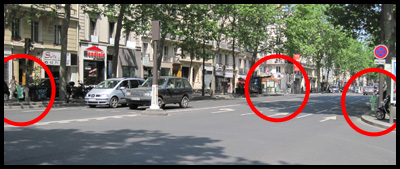
This is a European model American cities should follow. Cities need garbage collection infrastructure, so it might as well be cheap. If it can also be highly dispersed, maintained efficiently and used effectively by the public, that's even better.
And if it does things really well, it might even end up in a photo album from some nerd's vacation.

National Parks Layoffs Will Cause Communities to Lose Billions
Thousands of essential park workers were laid off this week, just before the busy spring break season.

Retro-silient?: America’s First “Eco-burb,” The Woodlands Turns 50
A master-planned community north of Houston offers lessons on green infrastructure and resilient design, but falls short of its founder’s lofty affordability and walkability goals.

Delivering for America Plan Will Downgrade Mail Service in at Least 49.5 Percent of Zip Codes
Republican and Democrat lawmakers criticize the plan for its disproportionate negative impact on rural communities.

Test News Post 1
This is a summary

Test News Headline 46
Test for the image on the front page.

Balancing Bombs and Butterflies: How the National Guard Protects a Rare Species
The National Guard at Fort Indiantown Gap uses GIS technology and land management strategies to balance military training with conservation efforts, ensuring the survival of the rare eastern regal fritillary butterfly.
Urban Design for Planners 1: Software Tools
This six-course series explores essential urban design concepts using open source software and equips planners with the tools they need to participate fully in the urban design process.
Planning for Universal Design
Learn the tools for implementing Universal Design in planning regulations.
EMC Planning Group, Inc.
Planetizen
Planetizen
Mpact (formerly Rail~Volution)
Great Falls Development Authority, Inc.
HUDs Office of Policy Development and Research
NYU Wagner Graduate School of Public Service


























